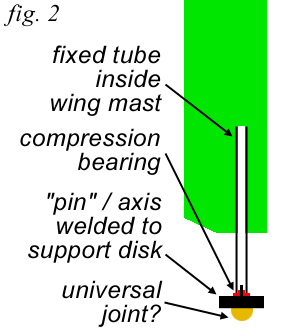Evolution of "Bucky Boom", balanced rotating rig...
Sat, 19 Jan 2002 12:51:42

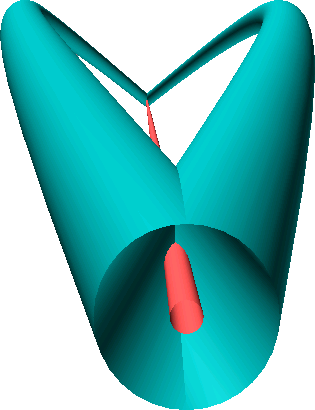 I see a structure at the pivot point that holds the two spars in position, has
attachment points for the wire going fore and aft, a base for the pivoting wing
mast on top, and the whole thing rotates with the boom (of course!).
I see a structure at the pivot point that holds the two spars in position, has
attachment points for the wire going fore and aft, a base for the pivoting wing
mast on top, and the whole thing rotates with the boom (of course!).
No need for supporting wires!!!
| DIMENSIONS as Drawn | |
|---|---|
| for 69 foot proa | for 19 foot proa |
| boom is 32 feet long spars are 2.0 feet out of column separated by 2.6 feet |
boom is 8.7 feet long spars are 6.6" out of column separated by 8.5" |
Tue, 22 Jan 2002 10:41:58
NOTE: Considered and dismissed alternative of two wires, one on either side of the mast, or single wire passing around base of mast... Won't work - lower fore and aft wire(s) must attach in center, not slide past that point!
Without a topping lift, the only thing supporting the weight of the main sail and anyone climbing on the boom is the stiffness of these spars. And while it does seem feasible to control dimensions precisely in this case, the angles between wire and spar are pretty bad; I worry about overloading.
Tue, 22 Jan 2002 13:10:03
OK, this still isn't quite right in some details(!) but close to what I have in
mind... Got impatient drawing little wire cylinders in MSurf so did some hasty
sketching in Photoshop:
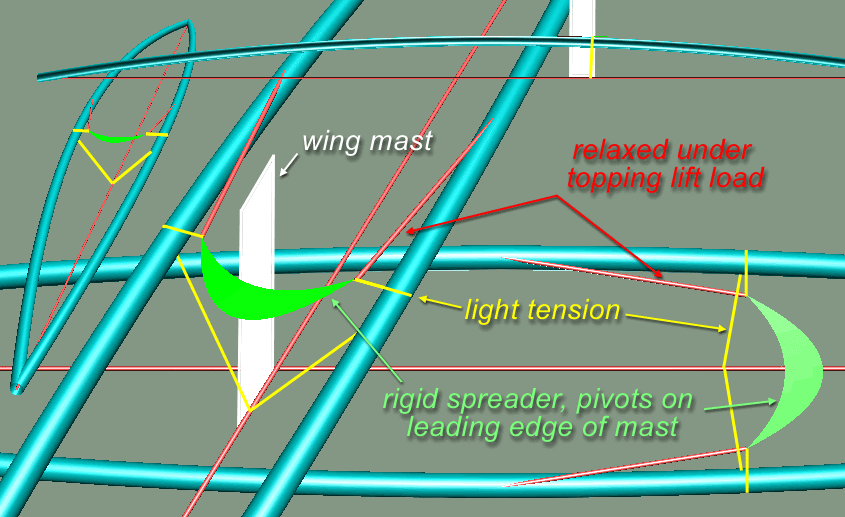
In fact, that green spreader should have tubular sections attached on each end that allow the spars to slide fore and aft but otherwise hold them in place. The lines marked in red come under tension only when the topping lift is slacked off and they keep the boom from tipping up in front; they are completely relaxed under normal mainsail load.
And instead of (or in addition to?) the yellow rigging to keep the spars in column, perhaps a triangular pattern of small line wrapped around each spar and the central wire acting as a basket for the dropped main?
Tue, 22 Jan 2002 14:40:13
Hand sketch!
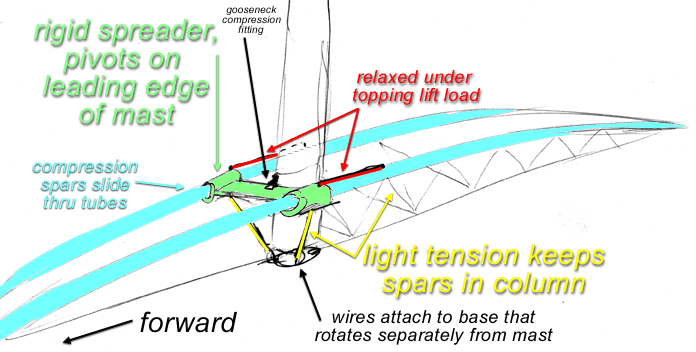
NOTE: The rigid spreader could hold a track for the clew of the self tending jib!
It might work better to pivot on the mast's vertical axis instead of the gooseneck fitting at the leading edge?
Tue, 22 Jan 2002 19:34:29
In this top view, the crossbar is fixed to the spars, not sliding (simpler and better for holding track for clew of self tending jib!). It is prevented from touching the mast by the short red lines in tension when the topping lift is slacked off; they are relaxed under normal mainsail or topping lift load.
The yellow "bungee" lines keep the spars centered either side of the mast.

Tue, 22 Jan 2002 22:40:59
Reality check!!?
I happen to have a couple of 8.5' sections of carbon tubes (windsurfer masts for my rudders) and there is NO WAY they will bend 6.6" out of column! Barely an inch or two at most.
So why would I want to find flimsy tubing to make this "bent bow" idea work? Or I suppose laminated spars could be made with the initial curve in them, like a real bow (for shooting arrows!).
Instead, it seems to me I'd want to use a pair of these straight, horizontal tubes, bent only slightly around a small diameter vertical axis of the wing mast. No need for a crossbar between them, no need for those yellow bungee lines.
The wire from each end would angle down to the base of the mast (like the Bucky boom).
A strap similar in function to those red lines could hold the boom forward (and up!) when the topping lift is relaxed.
Or even simpler, a fixed, padded stop between the spars (toward the jib end) would butt against the mast and limit movement aft when the topping lift is relaxed, keeping the boom's aft end elevated.
Designed properly, it can provide two additional functions:
- support the boom vertically on the mast, needed only when topping lift (or headstay) goes slack.
- limit movement of the boom forward in case the headstay breaks; the padded stop pulls away from the mast in this case.
Drawing will follow...
What about sideways forces from the sails on the ends of the boom? Depends, I guess, on the stiffness of the two spars and how they are attached to each other at the ends? Would be nice not to need spreaders to keep the boom straight in the horizontal plane.
Wed, 23 Jan 2002 14:56:16
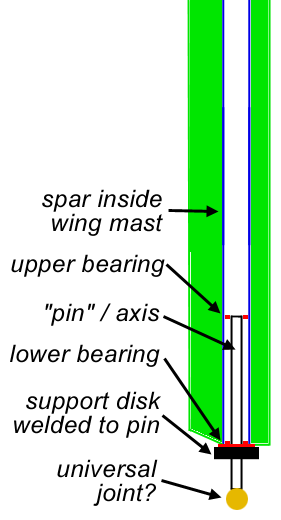 |
drawing and notes by Joseph Oster
Exploring an idea for supporting the rotating wing mast on a pin/disk arrangement. For a 17' wing mast (stayed at the top), the support disk would be welded a foot or so above the deck to an elongated "pin", providing a long vertical axis "buried" up inside the base of the wing (drawing not to scale!). Keeping the balestron boom below the support disk does the following:
Keeping the axis/pin narrow at this point avoids complications from trying to separate boom spars far enough to rotate the wing between them. The compression load would be at the base of the rotating wing mast, "lower bearing" in drawing. The top of the pin/axis would have no vertical load and manageable horizontal load, depending on the height up inside the mast. A first guess would be three or four times taller than the height of the lower disk support. So again for a 17' wing mast, this pin would be four feet tall? If the vertical axis, attached to the deck, extends far enough up inside the wing mast, it should be stable, even though the mast is sitting well above the deck. The "pin" / axis does not rotate; the mast and boom rotate independently around it. Is the universal joint really necessary? I believe Russ Brown uses a pin welded to a plate that is hinged on one side to allow lowering the mast. The mast sits on a Delrin disk wrapped around the pin. No U-joint, the little movement of the mast head apparently doesn't require any significant fore and aft or side to side motion at the mast base. |
Related pages:
|
| PacificProa.com | Other Proa Pages |
